Northampton Corporation Tramways
History
Northampton's 3ft-6ins-gauge, overhead electric tramway had a rather long gestation period, the corporation first expressing an interest in building a municipally owned electric tramway system in 1897. Negotiations with the Northampton Street Tramways Company — owners of the town's 3ft 6ins-gauge horse tramway — began the following year, but progress was slow, the NSTCo rejecting the corporation's final offer for the concern in 1900. The company, however, did a volte a face the following year after suffering a fatal and costly accident, seeking to accept the offer they had already declined; there is a sense that this may have been more in hope than in expectation, but their luck was in, and the corporation agreed.
In the meantime, the corporation had pressed on with its municipalisation agenda, having obtained powers — on April 22nd 1901 — to reconstruct the horse tramway for electric working and to operate the system itself.
The corporation took over operation on the 21st October 1901, working the horse tramway for almost three years pending conversion to electric traction. The corporation made several improvements to the horse tramway, which probably reflected the fact that plans for electrification were not as well-advanced as they might have been. Work on the new tramway did not actually start for another 27 months — in January 1904 — with another 6 months passing until the first electric service ran on the 21st July 1904. Once this milestone had been passed, work proceeded apace to finish the system, the last horse service running one month later on the 19th August, the electric trams taking over fully the following day.
The tramway was an immediate success, and though financial details are unclear (or at least unresearched), the fact that passenger numbers increased continually to a peak of 13.8 million in 1928, strongly suggests that it was a highly profitable enterprise.
Rather unusually for a municipal tramway, as built, it was almost a one-to-one match for the horse tramway, differing only by two very short extensions, one to the Kingsley line and the other to the Abington Park line. Powers to extend the tramway, as well as to introduce trolleybuses, were acquired in 1911, but the only improvement which actually materialised was a new line out to Far Cotton, which opened on the 23rd October 1914, and was in fact a conversion of a corporation horse-bus route.
The Far Cotton extension took the tramway to its final size of 6.41 miles. Like its horse-drawn predecessor, the centre of the system was situated opposite All Saints Parish Church along the Drapery and Mercers Row. Lines ran: southwards along Bridge Street and across the railway via a level crossing to Far Cotton; westwards along Gold Street then northwestwards along St James Road and Weedon Road to a terminus near Franklin Gardens at St James End; northwards along Kingsthorpe Road to Kingsthorpe; eastwards along Abington Street to Abington Square, where the line split, one line running northeastwards along Kettering Road to Kingsley and the other following Wellingborough Road eastwards then northeastwards to Abington Park.
Like most systems, Northampton suffered from the exigencies of the Great War, with shortages of staff (and skills), restrictions on the purchase of new track and vehicles, and an inability to do anything other than the minimum amount of maintenance. Although the system emerged from the conflict in poor condition, the arrears of maintenance were made good, four new tramcars were purchased and several more were refurbished/modified.
Although the corporation remained committed to the tramway undertaking, this did not stop it looking at other modes of transport, and in 1922, it introduced its first motorbuses, on routes that did not compete with the trams. The track on several routes was, however, now deteriorating badly, which no amount of maintenance and repair could rectify, expensive track renewal being the only option. The entire St James route was relaid between 1925 and 1927, but when the Wellingborough Road route (out to Abington Park) fell due in 1929, the corporation decided to experiment with a mixed tram and motorbus service, introducing the buses in September 1928 and withdrawing the trams completely on the 20th April 1929. The success of this measure didn't quite put paid to any thoughts of renewing the other lines, but when the costs of even minimal track renewal on the Kingsley route were calculated, the corporation once again opted for bus replacement, the line closing on the 31st August 1930. It is believed that the name of the department was altered to Northampton Corporation Transport shortly after this.
The track on the rest of the system, with the obvious exception of the St James route, became ever more decrepit, one councillor recording a staggering 27 derailments outside his premises on the Kingsthorpe route in a single day in 1932. New and rented motorbuses were eventually procured, the Kingsthorpe line closing on the 27th September 1933 and the last tram of all running, with due ceremony, on the 15th December 1934.
Uniforms
The corporation took over the assets of the erstwhile Northampton Street Tramways Company in 1901, and continued to run horse-drawn services for almost three years before electrification finally rendered them obsolete. Fortunately, two photographs have survived from this period, both of which show that the corporation continued to allow the men to wear informal attire, though it did see fit to issue them with kepi-style caps; the latter bore a metallic cap badge, possibly comprising the system initials — 'NCT' — in block letters.
Crews working the new electric services were issued with double-breasted jackets with three waist-level pockets (with flap closures), four pairs of buttons, and lapels; the collars carried an employee number on the bearer's left-hand side — in individual numerals — and system initials — 'N C T.' — on the right-hand side. It is unclear whether the insignia were brass or nickel, as buttons have survived in both materials, which suggests that a change was made from one to the other, most likely brass to nickel. The peaked caps were of the tensioned-crown type; they carried a script-lettering grade badge — either 'Conductor' or 'Motorman' — above which a small municipal-device badge was worn. Surprisingly, the general style of these uniforms remained unchanged for the entire life of the system (right through to closure in 1934), the only discernible alteration being the addition of a pair of buttons that fastened between the lapels and collars. Given that the corporation changed the name of the department in 1931, after this date, uniform issues to tramcar staff would probably have borne Northampton Corporation Transport insignia.
Tramcar crews were also issued with double-breasted greatcoats with five pairs of buttons, epaulettes (with button fastening) and high, fold-over collars; the latter appear to have carried the same insignia as the jackets, though in later years they may have carried system initials on both sides.
Inspectors were issued with single-breasted jackets with hidden buttons (or a more likely a hook and eye affair), the garment being edged in material of a finer quality (and possibly a different colour) than the main body, and embellished with braiding; they also bore epaulettes and stand-up collars, the latter bearing embroidered script-lettering system initials — 'NCT' — on both sides. Caps were initially in a kepi-style, though they were quickly superseded by a tensioned-crown type; they carried the bearer's grade — 'Inspector' — on a hat band in embroidered script lettering, above which a circular cloth cap badge bearing system initials was worn, again in embroidered script lettering. At some point, the jackets were changed to a double-breasted design with four pairs of buttons (dark coloured) and lapels; the upper part of the latter (i.e., the collars) certainly bore embroidered 'N C T' system initials on the right-hand side, and probably on the left-hand side as well. The cap insignia probably remained unchanged, though this cannot be made out with certainty on the surviving photographs.
In common with the vast majority of tramway systems, Northampton employed female staff during the Great War — as conductresses — to replace male employees lost to the armed services. These ladies were issued with stylish, tailored, lancer-style jackets with five pairs of buttons (narrowing from top to bottom) and stand-up collars; the latter carried an employee number on the bearer's left-hand side and system initials — 'N C T' — on the right-hand side (in individuals letters/numerals, almost certainly brass). A long matching skirt was also worn. In two of the three surviving photographs, the subjects are wearing waterproof bonnets, whilst the other shows a conductress in a straw bonnet. Both types of hat appear to have carried a hat band/ribbon, though whether they bore a badge — either embroidered or metal — remains unclear.
Further reading
For a history of the system, see: 'Northampton Corporation Tramways' by D R Howard, in the Tramway Review, No 128 (p227-246); Light Rail Transit Association (1986).
Images
Horse tram drivers and conductors
The crew of Horsecar No 20 pose for the cameraman in Weedon Road at its junction with Glasgow Street — photo undated, but certainly taken after the corporation take-over of 1901. Photo courtesy of the Tramways and Light Railway Society, with thanks to David Voice.
An enlargement of the above photograph showing the crew, both of whom are wearing informal attire, but with corporation-issued kepi-style caps. The latter bear a metallic cap badge, which though difficult to make out, probably comprised the system initials — ' NCT' — in block letters. The cars were painted in route colours, this one being green (with thanks to Alan Brotchie).
Horsecar No 23 outside the Kingsley Park Hotel on the Kingsley route in 1904. The tram would have been painted blue. With thanks to Alan Brotchie for the background information.
An enlargement of the above photograph showing the crew (Conductor E Patrick and Driver W Hoskins), both of whom are wearing informal attire, with the notable exception of Conductor Patrick's kepi-style cap, which once again hints at a 3-letter cap badge, almost certainly 'NCT.'
Motormen and conductors
A rather washed-out image, but one which shows a large number of staff assembled to mark a now long-forgotten occasion (possibly the opening) — photo undated, but undoubtedly very early in the system's life. Photo courtesy of the Graham Croucher Collection.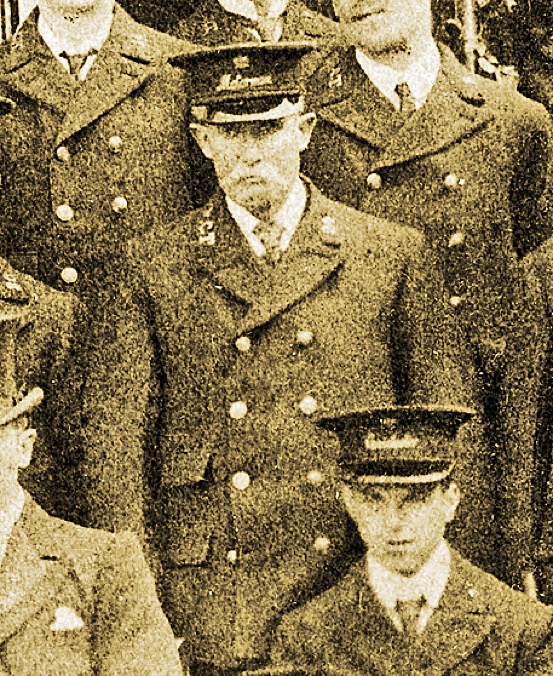
An enlargement of the photograph above showing a motorman, which although grainy, clearly shows that the collars bore system initials — 'N C T' — on the bearer's right-hand side, and an employee number on the left. The small badge worn above the script-lettering grade badge is almost certainly the same pattern as the municipal-device badge illustrated below. 
Northampton municipal-device badge, of the type worn on tramway employee cap throughout the life of the tramway — nickel. Author's Collection.
Standard script-lettering grade badges of the type used by Northampton Corporation Tramways — nickel. It is unclear what material Northampton used, as buttons exist in both brass and nickel, though more than likely a change was made from one to the other at some point. Author's Collection.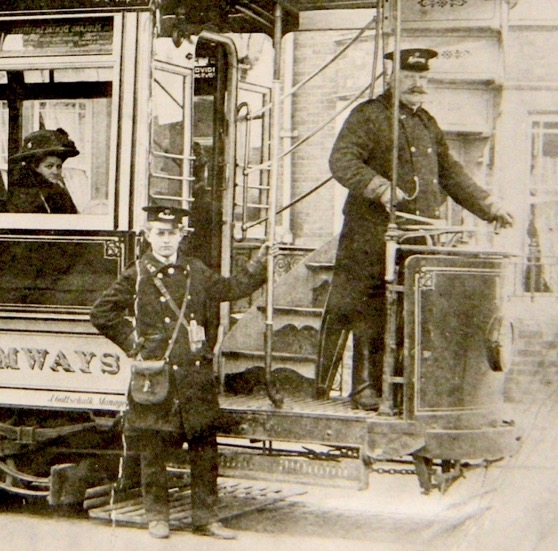
The crew of an unidentified tramcar on a service for Castle Station & St James, pose for the cameraman in corporation-issued greatcoats (with epaulettes) — photo undated, but probably early Edwardian. Photo courtesy of the Graham Croucher Collection.
A staff photo taken at the St James Road depot — undated, but probably late Edwardian. Photo courtesy of the Graham Croucher Collection.
An enlargement of the above photograph showing three motormen (rear) and four conductors (front). By this time, the jackets bore two additional buttons, which were mounted between the lapels and the collars; these were absent on the earliest uniforms.
The crew of Tramcar No 5 pose for the camera — photo purportedly taken in 1908. Source unknown.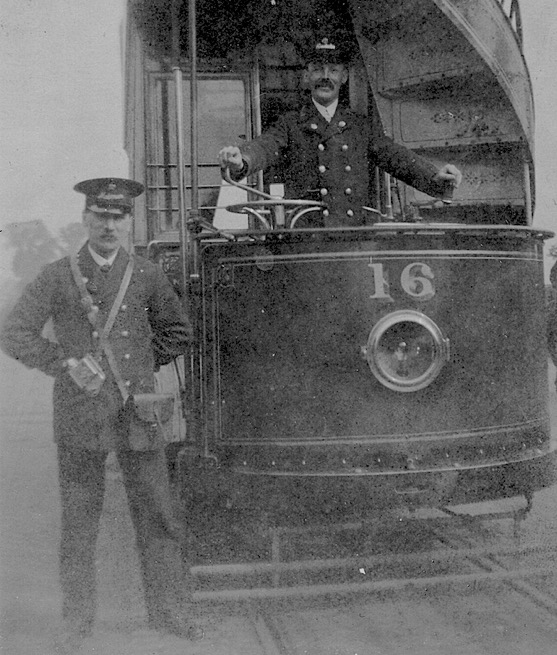
Tramcar No 16 and crew — photo undated, but probably late Edwardian. Photo courtesy of the Graham Croucher Collection.
A photograph of Motorman John Adams, who was apparently the oldest driver in the service of the NCT when the image was taken; unfortunately, the photo is undated, though it is probably late Edwardian. Photo courtesy of the Graham Croucher Collection.
Tramcar No 22 and crew — photo undated, but probably taken prior to the Great War.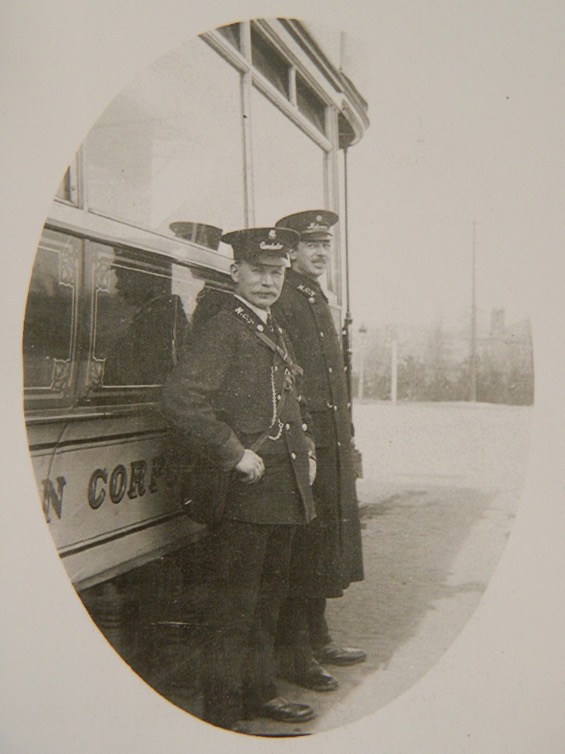
A tramcar crew pose for the cameraman with their unidentified charge — photo undated, though it has a pre-Great War air about it. Photo courtesy of the Graham Croucher Collection.
An enlargement of the above photograph showing the collar and cap badges.
Tramcar No 33 with Conductor John Leason and an unidentified motorman — photo undated, but possibly taken in the early 1920s. Photo courtesy of the Graham Croucher Collection. 
An inspector stands with Tramcar No 6 and its crew — photo undated, but very probably taken in the late 1920s or early 1930s. Photo courtesy of the Graham Croucher Collection.
Another shot of Tramcar No 6, this time at Kingsthorpe — photo again undated, but probably taken shortly before the system closed in 1934. Photo courtesy of the Graham Croucher Collection.
Tramcar No 34 on what looks to have been a foggy day, with a service bound for St James — photo undated, but probably taken in the 1930s. Photo by H Nicol, courtesy of the National Tramway Museum. 
An enlargement of the above photograph showing the motorman and the conductor, both in double-breasted greatcoats bearing epaulettes.
Senior staff
An enlargement of the early staff photo above showing two inspectors (on the tramcar platform at the back); they are wearing kepi-style caps and single-breasted jackets.
A studio portrait of Inspector Charles Edward Bennet — photo undated, but probably mid Edwardian. Photo courtesy of the Graham Croucher Collection.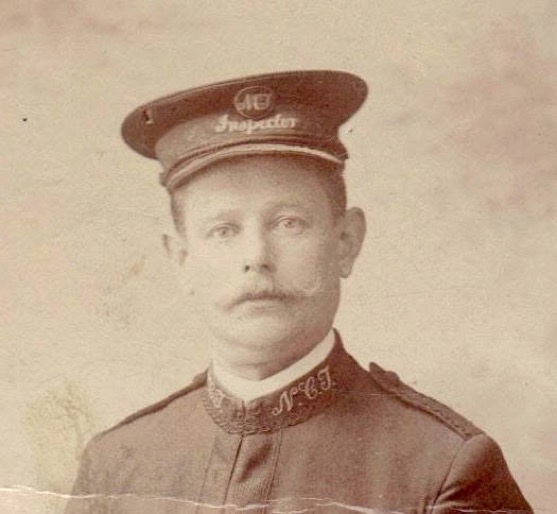
An enlargement of the above photograph showing the embroidered collar ('N.C.T.') and cap insignia ('Inspector'), the latter surmounted by a circular cap badge, almost certainly of embroidered cloth. 
A blow-up of the late-Edwardian depot photo above, showing an individual who is, in all probability, Inspector Bennet.
A much later shot of Inspector Bennet, probably taken in the 1920s or even the 1930s. His greatcoat bears embroidered insignia on each collar, almost certainly his grade, 'Inspector'. Photo courtesy of the Graham Croucher Collection.
An enlargement of the late 1920s/early 1930s photograph of Tramcar No 6 above, showing the inspector. By this time the uniform jacket had changed to a double-breasted design with dark buttons and lapels; the system initials — 'N C T' — can just be made out on the right-hand collar.
Female staff
A Northampton Corporation Tramways Great War conductress. The photograph was taken in the studios of Neil Powell, M.P.P.A., 62 Marefair, Northampton. Author's Collection.
An enlargement of the above photograph, which reveals the subject to have been Employee No 49. Her waterproof bonnet appears to bear a cap badge, probably the standard municipal-device badge.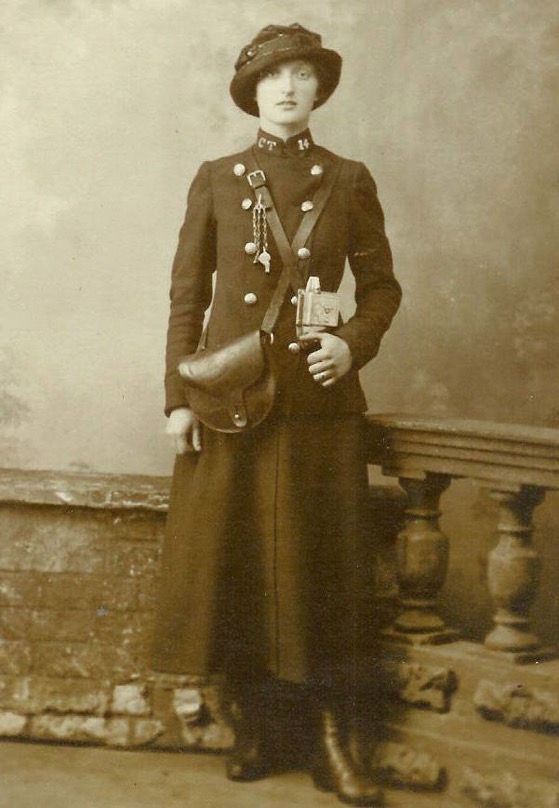
A Northampton Corporation Tramways Great War conductress, possibly a Ms Cunningham. Photo courtesy of the Graham Croucher Collection.
An enlargement of the above photograph showing details of the collar insignia, 'N C T' on the bearer's right-hand side and an employee number ('14') on the left. Her waterproof bonnet does not appear to bear a badge.
A rathered care-worn Tramcar No 19 with its conductress and motorman — photo undated, but almost certainly taken during the Great War.
An enlargement of the above photograph showing the conductress. She is wearing the standard female uniform, but with a straw bonnet as opposed to a waterproof bonnet.